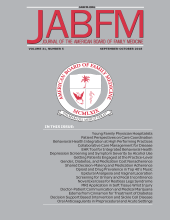Article Figures & Data
Tables
- Table 1.
Descriptive Statistics for Geriatric Continuity Clinic Variables Versus Mortality (n = 682)
Variable Patients (n) Overall Frequency (%) Proportion Dead (%) Proportion Alive (%) P Age (years) 60–74 69 10.2 94.2 5.8 75–84 287 42.5 79.8 20.2 85+ 320 47.3 80.6 19.4 .017 Sex Female 508 73.8 78.9 21.1 Male 179 26.2 88.8 11.2 .003 Race White 504 76.2 83.3 16.7 Nonwhite 161 23.8 75.2 24.8 .036 Education <High school 224 37.7 88.0 12.0 High school 186 31.3 78.5 21.5 >high school 184 31.0 75.0 25.0 .002 Smoker Yes 97 14.4 81.0 19.0 No 579 85.6 84.5 15.5 .41 ADL categories 0–6 43 6.5 100 0 7–13 326 49.4 87.7 12.3 14 291 44.1 71.8 28.2 <.0001 IADL categories 0–6 149 22.6 96.0 4.0 7–13 292 44.2 87.0 13.0 14 219 33.2 64.4 35.6 <.0001 Diabetes mellitus Yes 106 15.6 82.1 17.9 No 575 84.4 81.4 18.6 .87 Dementia Yes 250 36.7 94.8 5.2 No 431 63.3 73.8 26.2 <.001 Night sweats Yes 98 14.4 77.6 22.4 No 584 85.6 82.2 17.8 .27 ADL, activities of daily living; IADL, instrumental activities of daily living.
- Table 2.
Logistic and Cox Proportional Hazards Models for Mortality from the Geriatric Continuity Clinic Data Set
Without Function Variables With Function Variables Mortality* P Mortality* P Logistic model Age 0.95 (0.92–0.98) .002 0.96 (0.92–0.99) .015 Sex (female) 0.45 (0.24–0.81) .009 0.42 (0.24–0.75) .005 BMI 0.91 (0.87–0.95) <.0001 0.92 (0.88–0.96) .0002 ADL 0.83 (0.65–1.04) .03 IADL 0.88 (0.78–0.99) .03 Dementia 6.62 (3.45–14.08) <.0001 4.10 (2.03–8.30) <.0001 Night sweats 1.25 (0.68–2.38) .48 1.14 (0.60–2.24) .70 Cox proportional hazards model Age 0.96 (0.95–0.97) <.0001 0.96 (0.95–0.98) <.0001 Sex (female) 0.74 (0.61–0.89) .002 0.75 (0.61–0.90) .003 BMI 0.95 (0.94–0.97) <.0001 0.96 (0.94–0.98) <.0001 ADL 0.88 (0.85–0.95) <.0001 Dementia 2.02 (1.68–2.43) <.0001 1.75 (1.45–2.12) <.0001 Night sweats 1.29 (1.00–1.67) .054 1.21 (0.93–1.57) .16 * Data in Mortality columns provided as odds ratio (95 CI).
BMI, body mass index; ADL, activities of daily living; IADL, instrumental activities of daily living.
- Table 3.
Descriptive Variables for the Oklahoma Longitudinal Assessment of the Health Outcomes of Mature Adults Studies Data Set
Variable Patients (n) Overall Frequency (%) Proportion Dead (%) Proportion Alive (%) P Age (years) 60–74 99 11.6 38 62 75–84 522 62.0 21 79 85+ 222 26.4 31 69 <.0002 Sex Female 488 57.3 77 23 Male 364 42.7 71 29 .04 Race White 703 91.2 25 75 Nonwhite 139 8.8 32 68 .19 Education <High school 170 16.7 27 73 High school 209 24.6 24 76 >high school 464 58.7 26 74 .71 Annual income <$15,000 159 19.6 33 67 $15,000-$35,000 362 44.6 28 72 >$35,000 291 35.8 19 81 .003 Smoker Yes 61 7.6 33 67 No 736 92.4 24 76 .15 ADL categories 0–6 2 0.3 50 50 7–13 278 33.7 33 67 14 555 66.0 21 79 .0005 IADL categories 0–6 3 0.5 75 25 7–13 244 29.1 38 62 14 589 70.4 20 80 <.0001 Night sweats Yes 91 10.7 34 66 No 758 89.3 25 75 .05 Severe night sweats Yes 31 3.7 39 61 No 818 96.4 25 75 .09 ADL, activities of daily living; IADL, instrumental activities of daily living.
- Table 4.
Logistic and Cox Proportional Hazards Models for Mortality from the Oklahoma Longitudinal Assessment of the Health Outcomes of Mature Adults Studies Data Set
Without Function Variables With Function Variables Mortality* P Mortality* P Logistic models Age 0.99 (0.97–1.02) .88 0.96 (0.94–0.98) .001 Sex (female) 1.67 (1.18- 2.37) .004 2.28 (1.52–3.42) <.0001 BMI 0.96 (0.93–0.99) .02 0.93 (0.90–0.96) <.0001 Education 1.12 (1.01–1.22) .03 1.16 (1.04–1.29) .006 Income 0.83 (0.75–0.91) .0002 0.89 (0.80–0.99) .03 IADL score 0.78 (0.67–0.91) .002 50-foot timed walk 1.13 (1.09–1.18) <.0001 Night sweats† 0.72 (0.43–1.22) .25 0.98 (0.54–1.80) .95 Severe night sweats† 0.66 (0.29–1.48) .31 0.95 (0.36–2.53) .91 Cox proportional hazards models Age 0.99 (0.97–1.02) .47 0.96 (0.94–0.98) .001 Sex (female) 1.56 (1.17–2.09) .003 1.65 (1.20–2.26) .002 BMI 0.96 (0.94–0.99) .009 0.94 (0.92–0.97) <.0001 Education 1.10 (1.02–1.19) .02 1.11 (1.03–1.21) .01 Income 0.84 (0.77–0.91) <.0001 0.89 (0.81–0.98) .01 IADL score 0.80 (0.73–0.88) <.0001 50-foot timed walk 1.04 (1.03–1.05) <.0001 Night sweats† 1.28 (0.84–1.95) .26 1.13 (0.71–1.79) .62 Severe night sweats† 1.51 (0.79–2.86) .21 1.25 (0.61–2.58) .54 * Data in Mortality columns provided as odds ratio (95 CI).
† The variables “night sweats” and “severe night sweats” were added separately.
BMI, body mass index; IADL, instrumental activities of daily living.






